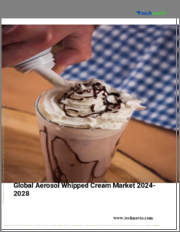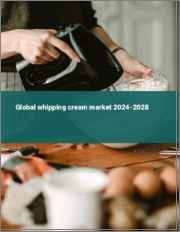
|
시장보고서
상품코드
1666028
휘핑크림 시장 규모, 점유율, 성장 분석 : 제품별, 유통 채널별, 용도별, 지역별 - 산업 예측(2025-2032년)Whipping Cream Market Size, Share, and Growth Analysis, By Product (Dairy, Light Whipping Cream), By Distribution Channel (Supermarkets and Hypermarkets, Convenience Stores), By Application, By Region - Industry Forecast 2025-2032 |
||||||
휘핑크림 시장 규모는 2023년에 32억 달러로 평가되며, 2024년 32억 9,000만 달러에서 2032년에는 40억 7,000만 달러로 성장하며, 예측 기간(2025-2032년)의 CAGR은 2.7%로 성장할 전망입니다.
세계 인구 증가로 인해 아이스크림, 컵케이크, 핫초코 밀크쉐이크 등 식품 및 음료 소비가 증가하면서 휘핑크림에 대한 수요가 크게 증가하고 있습니다. 초고온 처리와 같은 기술 혁신은 식감과 풍미를 유지하면서 보존 기간을 연장하고, 개봉할 때까지 냉장 보관하지 않고도 보관할 수 있습니다. 이러한 편의성은 특히 제빵 산업에서 휘핑크림이 부드러운 크럼을 가진 수분이 풍부한 케이크와 페이스트리를 만드는 데 필수적이며, 이는 소비자들에게 더욱 매력적으로 다가갈 수 있도록 합니다. 최근 유화 기술의 발전은 안정성을 높이고, 분리 위험을 줄이며, 레시피의 성능을 향상시켰습니다. 지방 함량이 30% 내외의 가벼운 휘핑크림 제품의 등장은 칼로리 섭취를 줄이지 않으면서도 매혹적인 선택을 원하는 건강 지향적인 소비자들을 만족시키며 시장 성장을 더욱 촉진하고 있습니다.
목차
서론
- 조사의 목적
- 조사 범위
- 정의
조사 방법
- 정보 조달
- 2차와 1차 데이터 방법
- 시장 규모 예측
- 시장의 전제조건과 제한
개요
- 세계 시장 전망
- 공급과 수요 동향 분석
- 부문별 기회 분석
시장 역학과 전망
- 시장 개요
- 시장 규모
- 시장 역학
- 촉진요인과 기회
- 억제요인과 과제
- Porter의 산업 분석
주요 시장 인사이트
- 주요 성공 요인
- 경쟁의 정도
- 주요 투자 기회
- 시장 에코시스템
- 시장의 매력 지수(2024년)
- PESTEL 분석
- 거시경제 지표
- 밸류체인 분석
- 가격 분석
- 규제 상황
- 사례 연구
- 고객과 구매 기준 분석
휘핑크림 시장 규모 : 제품별
- 시장 개요
- 유제품
- 라이트 휘핑크림
- 헤비 휘핑크림
- 기타
- 비유제품
휘핑크림 시장 규모 : 유통 채널별
- 시장 개요
- 슈퍼마켓과 하이퍼마켓
- 편의점
- 전문 소매업체
- 온라인 스토어
- 기타
휘핑크림 시장 규모 : 용도별
- 시장 개요
- 기업용
- 소비자용
휘핑크림 시장 규모
- 북미
- 미국
- 캐나다
- 유럽
- 독일
- 스페인
- 프랑스
- 영국
- 이탈리아
- 기타 유럽 지역
- 아시아태평양
- 중국
- 인도
- 일본
- 한국
- 기타 아시아태평양
- 라틴아메리카
- 브라질
- 기타 라틴아메리카 지역
- 중동 및 아프리카
- GCC 국가
- 남아프리카공화국
- 기타 중동 및 아프리카
경쟁 정보
- 상위 5사의 비교
- 주요 기업의 시장 포지셔닝(2024년)
- 주요 시장 기업이 채택한 전략
- 최근 시장 동향
- 기업의 시장 점유율 분석(2024년)
- 주요 기업의 기업 개요
- 기업의 상세
- 제품 포트폴리오 분석
- 기업의 부문별 점유율 분석
- 매출의 전년대비 비교(2022-2024년)
주요 기업 개요
- Cremo(Switzerland)
- Bulla Dairy Foods(Australia)
- Rich Products Corporation(USA)
- Greenfields(Indonesia)
- Muller Milk & Ingredients(United Kingdom)
- Lactalis(France)
- Arla Foods(Denmark)
- Fonterra(New Zealand)
- Amul(India)
- Nestle(Switzerland)
- Danone(France)
- Saputo Inc.(Canada)
- Dean Foods(USA)
- Meggle AG(Germany)
- FrieslandCampina(Netherlands)
- Parmalat(Italy)
- Groupe Lactalis(France)
- Yili Group(China)
- Mengniu Dairy(China)
- Morinaga Milk Industry(Japan)
결론과 제안
KSA 25.04.01Whipping Cream Market size was valued at USD 3.2 billion in 2023 and is poised to grow from USD 3.29 billion in 2024 to USD 4.07 billion by 2032, growing at a CAGR of 2.7% during the forecast period (2025-2032).
The global increase in population is driving higher consumption of food and beverage products like ice creams, cupcakes, and hot chocolate milkshakes, significantly boosting the demand for whipping cream. Innovations such as ultra-high temperature processing extend shelf life while preserving texture and flavor, allowing for non-refrigerated storage until opened. This convenience enhances consumer appeal, particularly in the expanding baking industry, where whipping cream is essential for creating moisture-rich cakes and pastries with a tender crumb. Recent advancements in emulsification technology also enhance stability, reducing separation risks and improving performance in recipes. The rise of light whipping cream products, with around 30% fat content, caters to health-conscious consumers seeking decadent options without compromising caloric intake, further propelling market growth.
Top-down and bottom-up approaches were used to estimate and validate the size of the Whipping Cream market and to estimate the size of various other dependent submarkets. The research methodology used to estimate the market size includes the following details: The key players in the market were identified through secondary research, and their market shares in the respective regions were determined through primary and secondary research. This entire procedure includes the study of the annual and financial reports of the top market players and extensive interviews for key insights from industry leaders such as CEOs, VPs, directors, and marketing executives. All percentage shares split, and breakdowns were determined using secondary sources and verified through Primary sources. All possible parameters that affect the markets covered in this research study have been accounted for, viewed in extensive detail, verified through primary research, and analyzed to get the final quantitative and qualitative data.
Whipping Cream Market Segments Analysis
Global Whipping Cream Market is segmented by Product, Distribution Channel, Application and region. Based on Product, the market is segmented into Dairy, Light Whipping Cream, Heavy Whipping Cream, Others and Non-Dairy. Based on Distribution Channel, the market is segmented into Supermarkets and Hypermarkets, Convenience Stores, Specialist Retailer, Online Stores and Others. Based on Application, the market is segmented into B2B and B2C. Based on region, the market is segmented into North America, Europe, Asia Pacific, Latin America and Middle East & Africa.
Driver of the Whipping Cream Market
The whipping cream market is driven by a significant increase in demand, primarily due to the growing global popularity of cakes, pastries, and various baked goods. As consumers increasingly seek out rich, visually appealing desserts, whipping cream is widely used to enhance both texture and presentation. This versatile ingredient has become essential in the food and confectionery sectors, catering to a range of culinary enthusiasts, from home bakers to professional pastry chefs. Its role in creating luscious and eye-catching confections underscores its importance, further propelling the market's growth as consumer preferences evolve towards indulgent treats.
Restraints in the Whipping Cream Market
The whipping cream market faces significant restraints due to the presence of various competitive alternatives, including lower-fat versions, whipped toppings, and non-dairy creamers. These substitutes tend to attract price-sensitive and health-conscious consumers by offering more affordable options with extended shelf lives. This competition poses a notable challenge, especially in areas where individuals opt for these alternatives over traditional whipped cream products for reasons of budget or dietary needs. As consumers increasingly seek healthier or more economical choices, the demand for whipping cream may diminish, further intensifying the competition within the culinary landscape.
Market Trends of the Whipping Cream Market
The whipping cream market is witnessing a significant trend towards increased demand for flavored whipping creams as consumers seek diversity and innovation in their culinary experiences. Varieties such as chocolate, vanilla, and caramel are gaining traction, allowing both professional chefs and home bakers to elevate their desserts and beverages with unique flavors. This shift reflects a broader consumer interest in experimenting with taste profiles, prompting manufacturers to diversify their product offerings to stay competitive. By introducing an array of flavored options, companies are not only catering to changing consumer preferences but also strengthening their market position in the increasingly crowded whipped cream sector.
Table of Contents
Introduction
- Objectives of the Study
- Scope of the Report
- Definitions
Research Methodology
- Information Procurement
- Secondary & Primary Data Methods
- Market Size Estimation
- Market Assumptions & Limitations
Executive Summary
- Global Market Outlook
- Supply & Demand Trend Analysis
- Segmental Opportunity Analysis
Market Dynamics & Outlook
- Market Overview
- Market Size
- Market Dynamics
- Drivers & Opportunities
- Restraints & Challenges
- Porters Analysis
- Competitive rivalry
- Threat of substitute
- Bargaining power of buyers
- Threat of new entrants
- Bargaining power of suppliers
Key Market Insights
- Key Success Factors
- Degree of Competition
- Top Investment Pockets
- Market Ecosystem
- Market Attractiveness Index, 2024
- PESTEL Analysis
- Macro-Economic Indicators
- Value Chain Analysis
- Pricing Analysis
- Regulatory Landscape
- Case Studies
- Customer & Buying Criteria Analysis
Global Whipping Cream Market Size by Product & CAGR (2025-2032)
- Market Overview
- Dairy
- Light Whipping Cream
- Heavy Whipping Cream
- Others
- Non-Dairy
Global Whipping Cream Market Size by Distribution Channel & CAGR (2025-2032)
- Market Overview
- Supermarkets and Hypermarkets
- Convenience Stores
- Specialist Retailer
- Online Stores
- Others
Global Whipping Cream Market Size by Application & CAGR (2025-2032)
- Market Overview
- B2B
- B2C
Global Whipping Cream Market Size & CAGR (2025-2032)
- North America (Product, Distribution Channel, Application)
- US
- Canada
- Europe (Product, Distribution Channel, Application)
- Germany
- Spain
- France
- UK
- Italy
- Rest of Europe
- Asia Pacific (Product, Distribution Channel, Application)
- China
- India
- Japan
- South Korea
- Rest of Asia-Pacific
- Latin America (Product, Distribution Channel, Application)
- Brazil
- Rest of Latin America
- Middle East & Africa (Product, Distribution Channel, Application)
- GCC Countries
- South Africa
- Rest of Middle East & Africa
Competitive Intelligence
- Top 5 Player Comparison
- Market Positioning of Key Players, 2024
- Strategies Adopted by Key Market Players
- Recent Developments in the Market
- Company Market Share Analysis, 2024
- Company Profiles of All Key Players
- Company Details
- Product Portfolio Analysis
- Company's Segmental Share Analysis
- Revenue Y-O-Y Comparison (2022-2024)
Key Company Profiles
- Cremo (Switzerland)
- Company Overview
- Business Segment Overview
- Financial Updates
- Key Developments
- Bulla Dairy Foods (Australia)
- Company Overview
- Business Segment Overview
- Financial Updates
- Key Developments
- Rich Products Corporation (USA)
- Company Overview
- Business Segment Overview
- Financial Updates
- Key Developments
- Greenfields (Indonesia)
- Company Overview
- Business Segment Overview
- Financial Updates
- Key Developments
- Muller Milk & Ingredients (United Kingdom)
- Company Overview
- Business Segment Overview
- Financial Updates
- Key Developments
- Lactalis (France)
- Company Overview
- Business Segment Overview
- Financial Updates
- Key Developments
- Arla Foods (Denmark)
- Company Overview
- Business Segment Overview
- Financial Updates
- Key Developments
- Fonterra (New Zealand)
- Company Overview
- Business Segment Overview
- Financial Updates
- Key Developments
- Amul (India)
- Company Overview
- Business Segment Overview
- Financial Updates
- Key Developments
- Nestle (Switzerland)
- Company Overview
- Business Segment Overview
- Financial Updates
- Key Developments
- Danone (France)
- Company Overview
- Business Segment Overview
- Financial Updates
- Key Developments
- Saputo Inc. (Canada)
- Company Overview
- Business Segment Overview
- Financial Updates
- Key Developments
- Dean Foods (USA)
- Company Overview
- Business Segment Overview
- Financial Updates
- Key Developments
- Meggle AG (Germany)
- Company Overview
- Business Segment Overview
- Financial Updates
- Key Developments
- FrieslandCampina (Netherlands)
- Company Overview
- Business Segment Overview
- Financial Updates
- Key Developments
- Parmalat (Italy)
- Company Overview
- Business Segment Overview
- Financial Updates
- Key Developments
- Groupe Lactalis (France)
- Company Overview
- Business Segment Overview
- Financial Updates
- Key Developments
- Yili Group (China)
- Company Overview
- Business Segment Overview
- Financial Updates
- Key Developments
- Mengniu Dairy (China)
- Company Overview
- Business Segment Overview
- Financial Updates
- Key Developments
- Morinaga Milk Industry (Japan)
- Company Overview
- Business Segment Overview
- Financial Updates
- Key Developments















